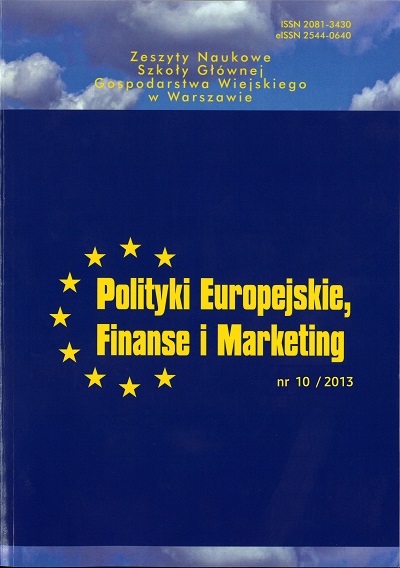Main Article Content
The company can be funded from a variety of sources such as foreign or own capital. This article will be devoted to the analysis of foreign sources of funding in the agricultural sector for selected years while specific ratios have been selected. Ratio of debt is in general a ratio of outputs of each balance sheet and profit and loss statement of a company with the regard to the items which are characterizing the actual debt. Based on it is possible to monitor and analyze the financial resources of the company. Hence it is the ratio of equity and foreign capital in the business, while this situation has of course an impact on corporate financial stability, but also on the return on equity, debt or credit. For the purposes of developing this article it has been worked with the data of Slovak agriculture companies in the chosen period of 2004- 2011. We assume that farms will use the optimal proportion of debt and equity capital.
Article Details
Knápková, A. - Pavelková, D. - Štekel. K. 2013. Finanční analýza: komplexní průvodce s příklady. Praha: Grada, 2013. 236 s. ISBN 978-80-247-4456-8
Miklovičová, J. - Gurčík, Ľ.: Aplikácia ukazovateľov a modelov finančnej analýzy na vybrané mliekarne. Nitra: SPU, 2008. 216 s. ISBN 978-80-552-0133-7
Serenčéš, P. - Serenčéš, R. - Tóth, M. - Čierna, Z. - Rábek, T. 2010. Financie v poľnohospodárstve. Nitra: SPU, 2010. 188 s. ISBN 978-80-552-0438-3
Downloads
- Johana Paluchová, Renata Prokeinová, SUSTAINABILITY IN SERVICE´S SECTOR: NEW TRENDS OF SUSTAINABILITY TOOLS AND POSITIONING OF SERVICES IN ECONOMY , The Scientific Journal European Policies, Finance and Marketing: No. 10(59) (2013)
You may also start an advanced similarity search for this article.
- Zuzana Čierna, Jana Prevužňáková, APPLICATION OF ACTIVITY INDICATORS IN SLOVAK AGRICULTURAL ENTERPRISES , The Scientific Journal European Policies, Finance and Marketing: No. 10(59) (2013)
- Tomáš Rábek, Marián Tóth, DEVELOPMENT OF PROFITABILITY IN SLOVAK AGRICULTURAL ENTERPRISES IN YEARS 2004-2011 , The Scientific Journal European Policies, Finance and Marketing: No. 10(59) (2013)
- Zuzana Gallová, Peter Serenčéš, Influence of cash flows from the Common Agricultural Policy on liquidity of Slovak trading companies in agriculture in the period 2000-2009 , The Scientific Journal European Policies, Finance and Marketing: No. 5(54) (2011)
- Jana Prevužňáková, Katarína Zemková, The Analysis of the Indebtedness of Slovak Agricultural Enterprises in Years 2003 and 2009 and Multi-criteria Analysis of Slovak Agricultural Enterprises in Years 2003 and 2009 , The Scientific Journal European Policies, Finance and Marketing: No. 7(56) (2012)
- Zuzana Čierna, Tomáš Rábek, Marián Tóth, Impact of CAP on the Cash-Flow Components in Slovak Agriculture , The Scientific Journal European Policies, Finance and Marketing: No. 7(56) (2012)
- Jana Prevužňáková, Peter Serenčéš, Marián Tóth, Impact of Direct Payment Reform of CAP 2014–2020 on the Economy of Agricultural Enterprises in Slovakia , The Scientific Journal European Policies, Finance and Marketing: No. 7(56) (2012)

This work is licensed under a Creative Commons Attribution-NonCommercial 4.0 International License.
All articles published in European Policies, Finance and Marketing are fully open access. In this way, the scientific research results contained in articles published in our journal are available to every reader free of charge - in accordance with the CC BY-NC license (https://creativecommons.org/licenses/by-nc/4.0/).
According to the CC BY-NC license you are free to:
- Share — copy and redistribute the material in any medium or format
- Adapt — remix, transform, and build upon the material
The licensor cannot revoke these freedoms as long as you follow the license terms.
Under the following terms:
- Attribution — You must give appropriate credit , provide a link to the license, and indicate if changes were made . You may do so in any reasonable manner, but not in any way that suggests the licensor endorses you or your use.
- NonCommercial — You may not use the material for commercial purposes .
- No additional restrictions — You may not apply legal terms or technological measures that legally restrict others from doing anything the license permits.
Source: https://creativecommons.org/licenses/by-nc/4.0/deed.en
According to that, the authors retain the copyright and full publishing rights.





